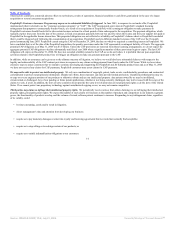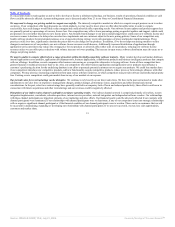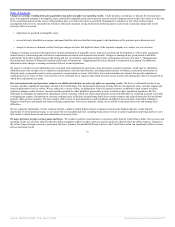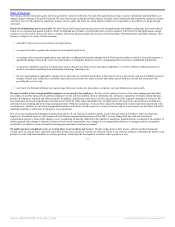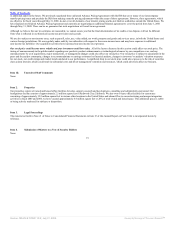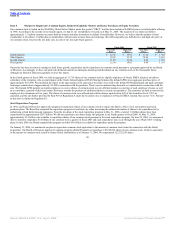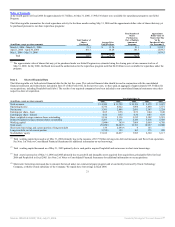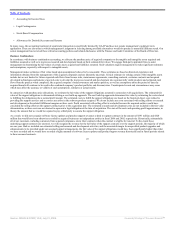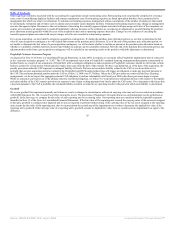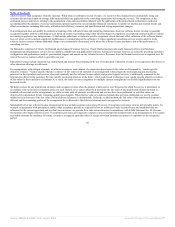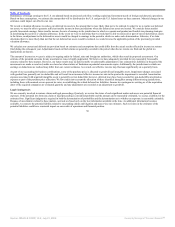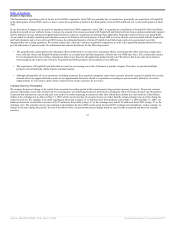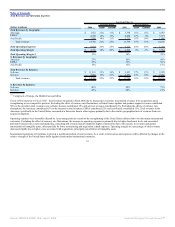Oracle 2005 Annual Report Download - page 26
Download and view the complete annual report
Please find page 26 of the 2005 Oracle annual report below. You can navigate through the pages in the report by either clicking on the pages listed below, or by using the keyword search tool below to find specific information within the annual report.
Table of Contents
Software license updates and product support revenues, which represent approximately 46% of our total revenues on a trailing 4-quarter basis, is our highest
margin business unit. Support margins over the last trailing 4-quarters were 89%, and account for 74% of our total margins over the same respective period. We
believe that software license updates and product support revenues and margins will continue to grow for the following reasons:
• Acquisitions over the past two years have significantly increased our support contract base, as well as the portfolio of products available to be licensed.
• Substantially all customers purchase license updates and product support subscriptions when they buy new software licenses, resulting in a further increase
in our support subscription contract base. Even if license revenue growth was flat, software license updates and product support revenues would continue
to grow assuming renewal and cancellation rates remained relatively constant since substantially all new software license transactions add to the support
contract base.
• Substantially all of our customers, including customers from acquired companies, renew their support contracts when eligible for renewal.
• When support contract renewals are negotiated, inflationary price increases are assessed, where applicable.
We record adjustments to reduce support obligations assumed in business acquisitions to their estimated fair value at the acquisition dates. As a result, we did not
recognize software license updates and product support revenues related to support contracts in the amount of $391 million and $320 million that would have
been otherwise recorded by acquired businesses as independent entities in fiscal 2006 and 2005, respectively. To the extent underlying support contracts are
renewed, we will recognize the revenue for the full value of the support contracts over the support periods, the majority of which are one year.
Services Business
Our services business consists of consulting, On Demand and education revenues. Our services business, which represents 20% of our total revenues on a trailing
4-quarter basis, has significantly lower margins than our software business.
Consulting: Consulting revenues tend to lag software revenues by several quarters since consulting services, if purchased, are typically performed after the
purchase of new software licenses. Consulting revenues have been negatively impacted in recent periods for the following reasons:
• Continued attrition of personnel due to a demand for technical talent in certain markets, particularly in the United States.
• A shift in the mix of resources to lower cost countries, which has resulted in a decrease in average billing rates.
• Our decision to work more closely with partners who perform implementations of our software.
Despite these trends, we expect consulting revenues to increase in fiscal 2007, primarily due to an increase in application implementations related to acquired
products and the addition of personnel acquired from Siebel.
On Demand: On Demand includes our Oracle On Demand ‘software as a service’ and outsourcing offerings as well as Advanced Customer Services. We
believe that our On Demand offerings provide an additional opportunity for customers to lower their total cost of ownership and can therefore provide us with a
competitive advantage. We will continue to make investments in Oracle On Demand to support current and future revenue growth, which may negatively impact
future On Demand margins.
Education: The purpose of our education services is to further enhance the usability of our software products by our customers and to create opportunities to
grow software revenues. Education revenues have been impacted by personnel reductions in our customers’ information technology departments, tighter controls
over discretionary spending and greater use of outsourcing solutions. Despite these trends, we expect education revenues to increase in fiscal 2007, primarily due
to an increase in customer training on the use of our acquired application products.
23
Source: ORACLE CORP, 10-K, July 21, 2006 Powered by Morningstar® Document Research℠



